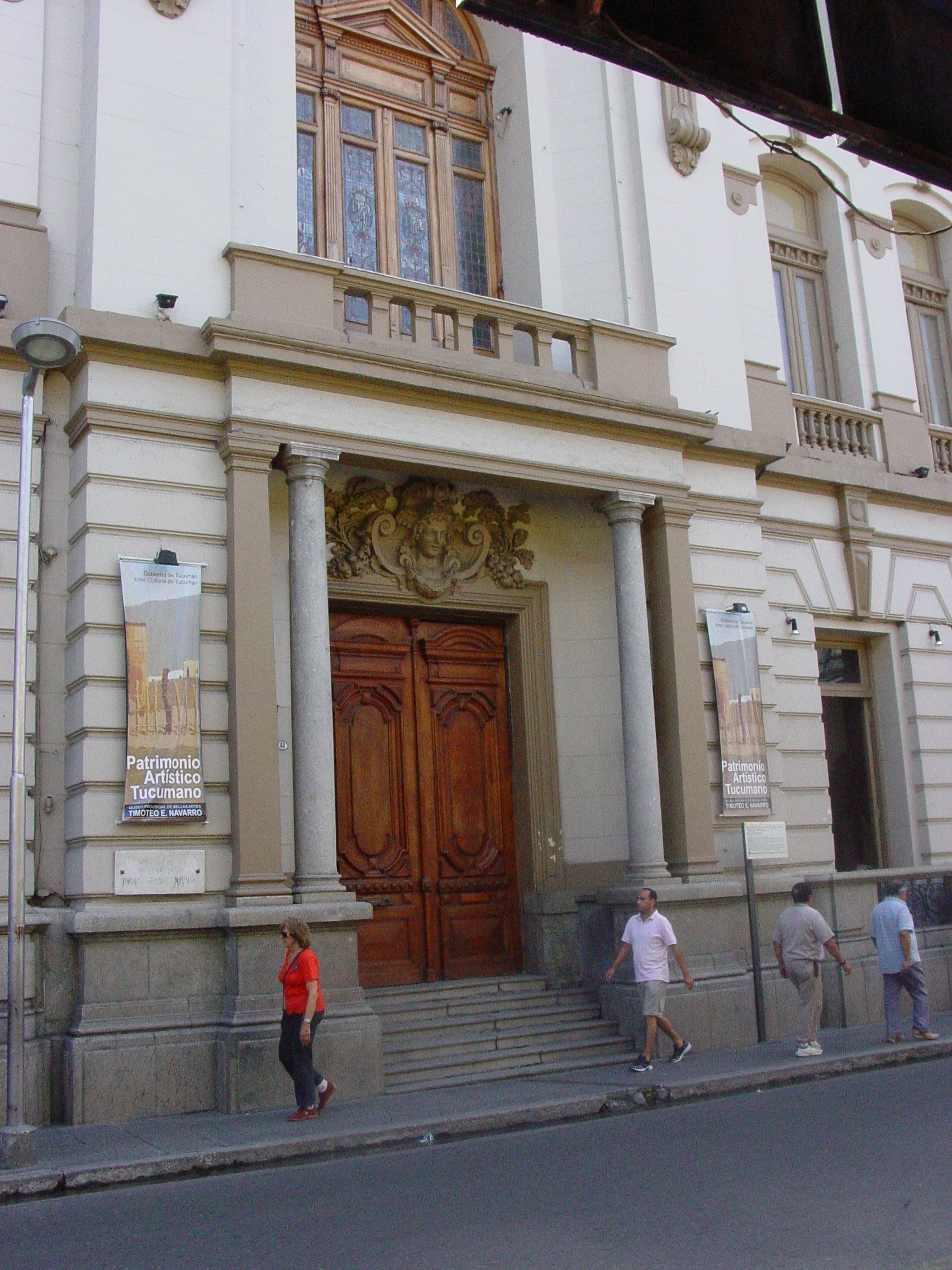Timoteo Navarro Museum of Art on:
[Wikipedia]
[Google]
[Amazon]
 The Timoteo Navarro Provincial Museum of Fine Arts is the leading museum of its kind in Tucumán Province,
The Timoteo Navarro Provincial Museum of Fine Arts is the leading museum of its kind in Tucumán Province,
Tucumán es cultura: Museo Provincial de Bellas Artes Timoteo Navarro
{{DEFAULTSORT:Timoteo Navarro Museum Of Art Art museums and galleries in Argentina Buildings and structures in San Miguel de Tucumán Buildings and structures completed in 1905 Art museums and galleries established in 1916 National Historic Monuments of Argentina 1916 establishments in Argentina Museums in Tucumán Province
Argentina
Argentina (), officially the Argentine Republic ( es, link=no, República Argentina), is a country in the southern half of South America. Argentina covers an area of , making it the second-largest country in South America after Brazil, th ...
.
Overview
The museum was first proposed by a prominent local lawyer and educator, , who in 1912 established theNational University of Tucumán
The National University of Tucumán ( es, Universidad Nacional de Tucumán, UNT) is an Argentine national university located in Tucumán Province and the largest in Argentina's northwest region. Founded on 25 May 1914 in San Miguel de Tucumán ...
. The museum was conceived to complement the new university's School of Fine Arts, and on June 18, 1916, the institution was inaugurated as the first in the city of San Miguel de Tucumán.
The museum became an autonomous entity in 1922, and in 1931, it was transferred to larger facilities. It was again transferred in 1957 to the historic home of former President Nicolás Avellaneda, though the building's deteriorating state led to the museum's closure in 1997, and its collections were temporarily moved to the provincial Secretariat of Culture. The closure of a landmark branch of the Bank of the Province of Tucumán and its designation as a National Historic Monument allowed the Secretariat of Culture to relocate the growing collections to its present site, reinaugurating the museum on September 29, 2003.
Renamed in honor of the famed local sculptor Lola Mora
Dolores Candelaria Mora Vega (November 17, 1866 – June 7, 1936) known professionally as Lola Mora, was a sculptor born in San Miguel de Tucumán, in Argentina. She is known today as a rebel and a pioneer of women in her artistic field.
Early ...
in 1975, the museum was again renamed in 1986 in honor of local painter and art instructor .
The museum is housed in an eclectic, baroque
The Baroque (, ; ) is a style of architecture, music, dance, painting, sculpture, poetry, and other arts that flourished in Europe from the early 17th century until the 1750s. In the territories of the Spanish and Portuguese empires including t ...
and French neoclassical building designed in 1905 by Belgian-Argentine architect Alberto Pelsmaekers (18551923). The main hall, where the majority of the museum's exhibits are displayed, is a 400 m2 (4,200 ft²) space topped by a two-story ceiling and a skylight
A skylight (sometimes called a rooflight) is a light-permitting structure or window, usually made of transparent or translucent glass, that forms all or part of the roof space of a building for daylighting and ventilation purposes.
History
Open ...
, a 144 m2 (1,500 ft²) glass and iron structure sustained by wrought-iron pillars.
Its permanent collections, the most important in the Argentine Northwest, include over 680 works, including paintings, sketches, lithograph
Lithography () is a planographic method of printing originally based on the immiscibility of oil and water. The printing is from a stone (lithographic limestone) or a metal plate with a smooth surface. It was invented in 1796 by the German a ...
s, ceramics, sculptures, illustrated poems and photographs. Among the Argentine artists represented are: , Antonio Berni
Delesio Antonio Berni (14 May 1905 – 13 October 1981) was an Argentine figurative artist. He is associated with the movement known as ''Nuevo Realismo'' ("New Realism"), an Argentine extension of social realism. His work, including a serie ...
, Pío Collivadino
Pío Collivadino (August 20, 1869August 26, 1945) was an Argentine painter of the post-impressionist school.
Life and work
Pío Collivadino was born in Buenos Aires, in 1869. He studied drawing at the Italian Argentine cultural society, the ''S ...
, , Luis Lobo de la Vega
Luis is a given name. It is the Spanish form of the originally Germanic name or . Other Iberian Romance languages have comparable forms: (with an accent mark on the i) in Portuguese and Galician, in Aragonese and Catalan, while is archaic ...
, , Antonio Pujía
Antonio Pujía (11 June 1929 – 26 May 2018) was an Argentinian sculptor. Through his artwork he always both honoured women and also denounced the world's horrors of famine and war.
Personal life
Antonio Pujía was born in Polia, a small town i ...
, Benito Quinquela Martín
Benito Quinquela Martín (March 1, 1890 – January 28, 1977) was an Argentine painter. Quinquela Martín is considered the port painter-par-excellence and one of the most popular Argentine painters. His paintings of port scenes show the activit ...
, Cesáreo Bernaldo de Quirós
Cesáreo Bernaldo de Quirós (May 27, 1879 – May 29, 1968) was an Argentine painter of the post-impressionist school.
Life and work
De Quirós was born in Gualeguay, Entre Ríos Province, in 1879. He began to paint at age eight, and shortly ...
, and Lino Enea Spilimbergo
Lino Enea Spilimbergo (born Lino Claro Honorio Enea Spilimbergo; 12 August 1896 – 16 March 1964) was an Argentine artist and engraver considered to be one of the country's most important painters.
Biography
Lino Enea Spilimbergo was born i ...
.
External links
Tucumán es cultura: Museo Provincial de Bellas Artes Timoteo Navarro
{{DEFAULTSORT:Timoteo Navarro Museum Of Art Art museums and galleries in Argentina Buildings and structures in San Miguel de Tucumán Buildings and structures completed in 1905 Art museums and galleries established in 1916 National Historic Monuments of Argentina 1916 establishments in Argentina Museums in Tucumán Province